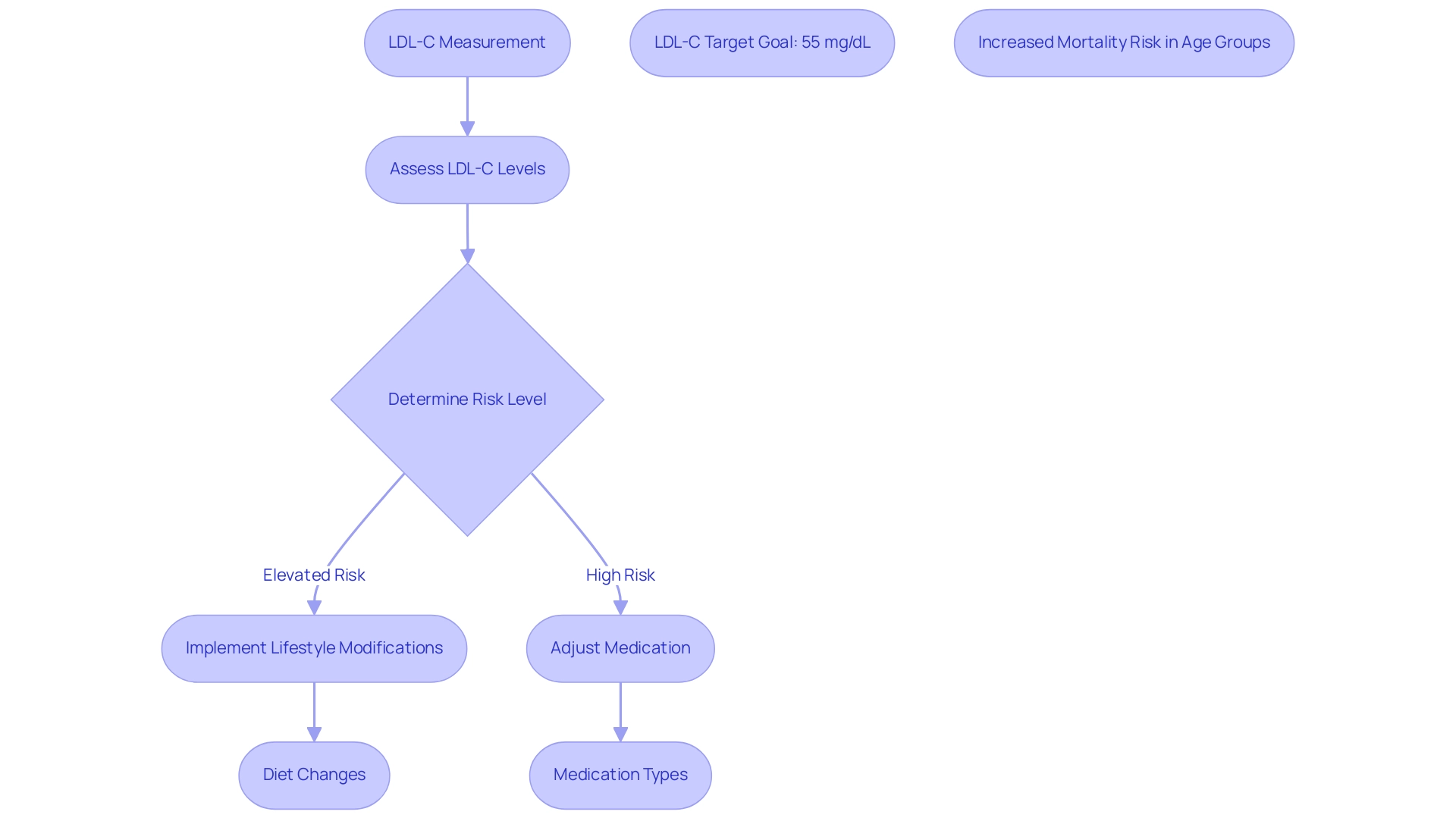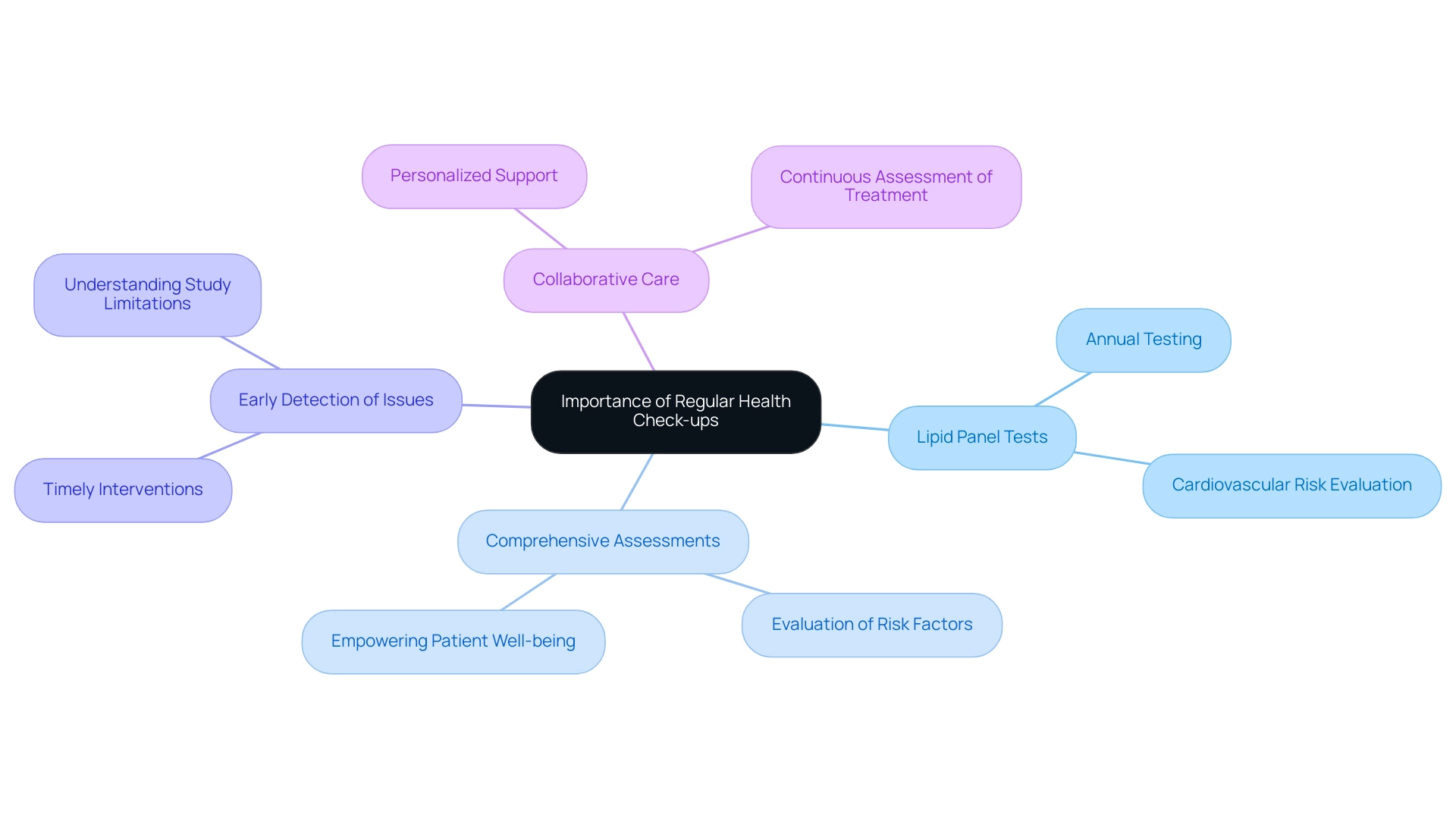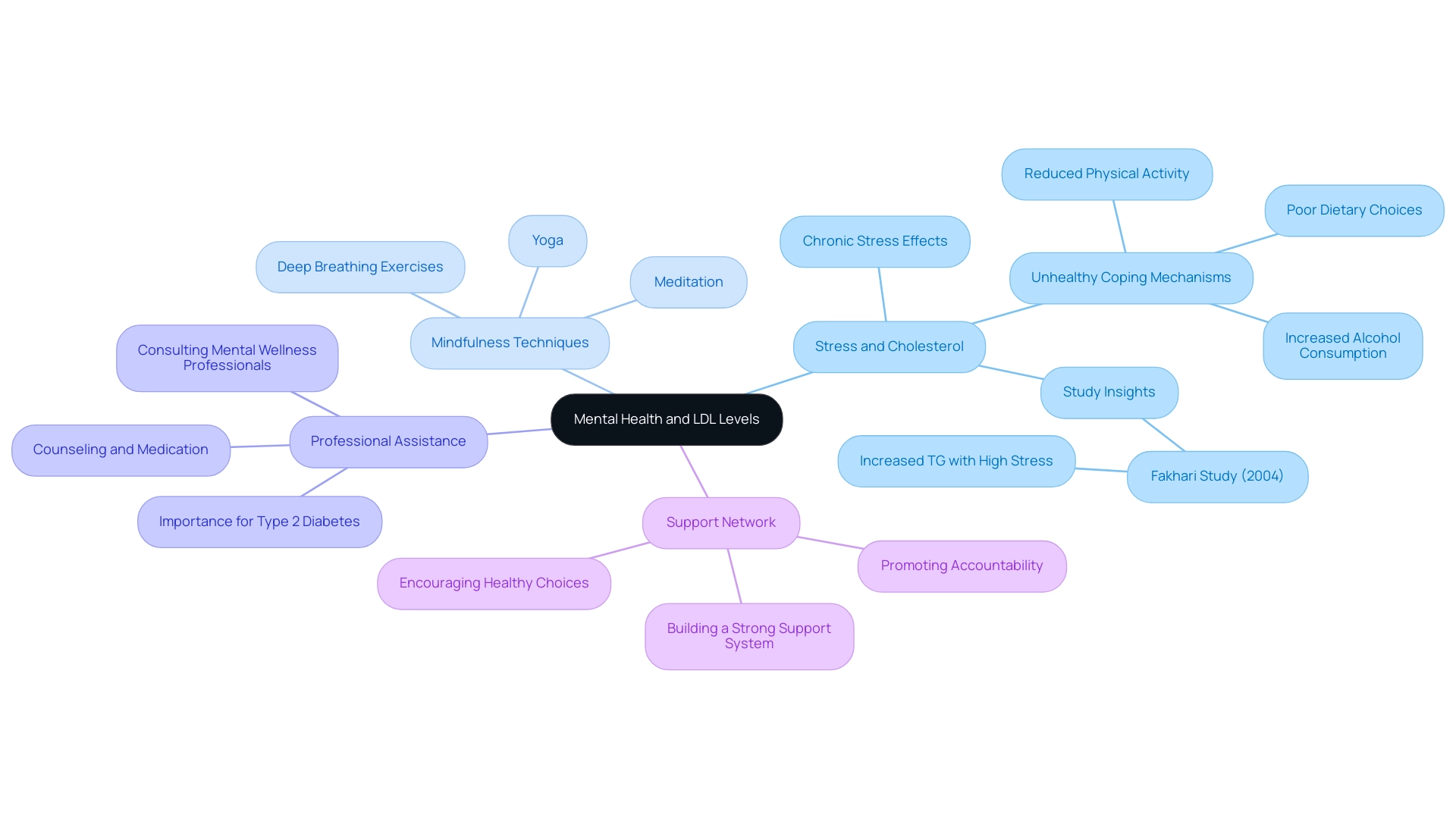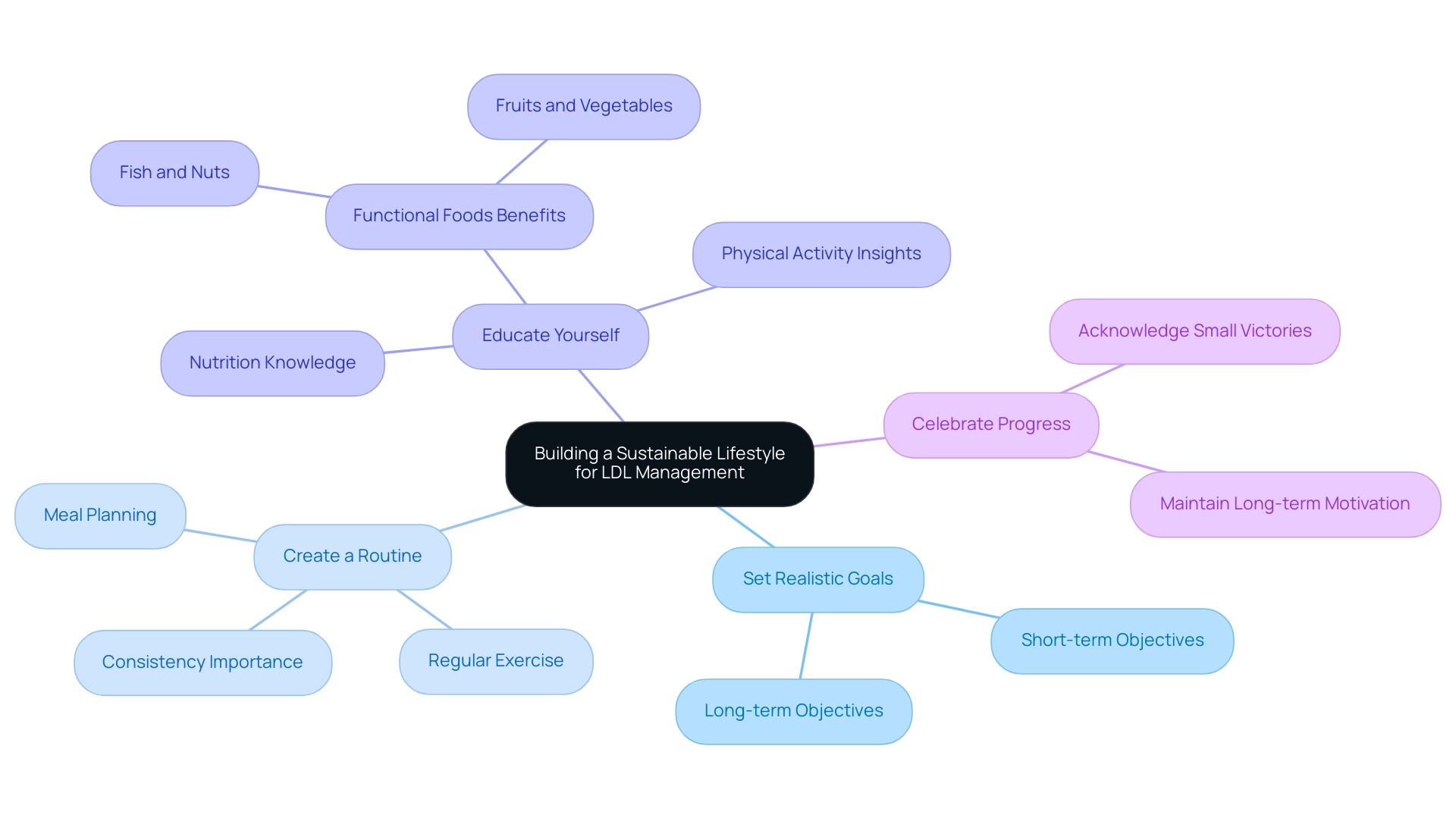Overview
To achieve an LDL cholesterol goal of 55 mg/dL, individuals should implement a comprehensive strategy that includes dietary modifications, regular physical activity, weight management, medication adherence, and routine health check-ups. The article emphasizes that these approaches are supported by clinical guidelines and research, highlighting the importance of lifestyle changes and monitoring in effectively managing LDL levels and reducing the risk of cardiovascular complications.
Introduction
Low-Density Lipoprotein Cholesterol (LDL-C), often referred to as “bad” cholesterol, poses significant health risks, particularly for individuals managing type 2 diabetes. Elevated LDL-C levels are closely linked to increased chances of cardiovascular diseases, making regular monitoring and effective management crucial.
This article explores the multifaceted approach to LDL-C management, emphasizing the importance of:
- Lifestyle modifications
- Dietary choices
- Physical activity
- Mental health
in achieving optimal cholesterol levels. By understanding the critical role of LDL-C in overall health, individuals can adopt proactive strategies that not only mitigate health risks but also enhance their quality of life.
The Critical Role of LDL-C Measurement in Health Management
Low-Density Lipoprotein Cholesterol (LDL-C) is often labeled as ‘bad’ cholesterol due to its strong correlation with an elevated risk of cardiovascular diseases, particularly among individuals with type 2 diabetes. Elevated LDL-C levels can significantly exacerbate diabetes-related complications, including heart disease and stroke. Thus, consistent tracking of LDL-C is crucial as part of a comprehensive strategy for diabetes care at the Integrative Wellness Center, which enables patients to remove anxiety about possible wellness concerns.
By understanding how effective LDL-C control can alleviate worries about diabetes complications, patients can engage in proactive strategies that allow for timely interventions—whether lifestyle modifications or adjustments in medication—to help maintain their cholesterol within the recommended target range. Clinical guidelines recommend an LDL goal of 55 mg/dL, highlighting its importance as a key quality metric in health oversight and preventive care. Recent research has further clarified the relationship between LDL-C levels and mortality risk, revealing that higher LDL-C levels are associated with increased mortality, particularly in older age groups.
Adjusted hazard ratios indicate a notable rise in risk for patients aged 50-69 and 70-89 years. Furthermore, a prospective cohort study emphasized a U-Shaped association between high-density lipoprotein cholesterol and the occurrence of total, ischemic, and hemorrhagic stroke, highlighting the significance of balanced lipid control. As Dr. Paul M. Ridker states, ‘Effective control of LDL-C is crucial for reducing cardiovascular risk and improving overall health outcomes in diabetic patients.’
This careful oversight of LDL-C, integrated with education and holistic care, can play a vital role in reducing the risk of cardiovascular events and alleviating anxiety about diabetes complications, making it a fundamental component of diabetes care at the Integrative Wellness Center.
Innovative Strategies for Achieving LDL Goals
To meet the LDL goal 55 mg/dL, a comprehensive strategy that includes various lifestyle modifications is necessary. Here are several innovative approaches to consider:
- Dietary Modifications: Prioritize a heart-healthy diet abundant in fruits, vegetables, whole grains, and healthy fats. Notably, foods high in soluble fiber, such as oats and legumes, are instrumental in reducing LDL amounts. A meta-analysis of the Nordic diet has demonstrated a reduction in LDL-C by an average of 11.7 mg/dL, underscoring the importance of dietary choices. Additionally, incorporating plant sterols and stanols, found in various plant-based foods, can be beneficial; consuming 2 to 3 grams of plant sterols or stanols daily can lower LDL-C by approximately 12%, making them an effective dietary modification.
- Regular Physical Activity: Aim for at least 150 minutes of moderate-intensity aerobic exercise each week. Participating in consistent physical exercise not only helps in improving lipid profiles but also boosts overall cardiovascular health, aiding in better management of diabetes.
- Weight Management: Maintaining a healthy weight can significantly affect LDL concentrations. Research indicates that even modest weight loss can lead to notable improvements in cholesterol profiles, assisting individuals in achieving their LDL goal 55.
- Medication Adherence: For some patients, lifestyle changes may not be sufficient to achieve desired LDL values. Consistently following prescribed statins or other cholesterol-lowering medications is essential for reaching LDL targets. As noted by health experts, “a marked decrease in LDL-C was observed (from 153 mg/dL decreasing to 96 mg/dL)” when adhering to these medications, illustrating their potential effectiveness.
- Regular Monitoring: Frequent check-ups and lipid panel tests are crucial for tracking progress. Regular evaluations can guide essential modifications to treatment plans, ensuring that LDL-C values are on the right trajectory.
- Stress Management: Persistent stress is recognized to negatively influence lipid concentrations. Incorporating stress-reducing practices, such as mindfulness or yoga, can provide significant benefits, promoting a healthier lipid profile.
- Support Systems: Engaging with support groups or collaborating with a wellness coach can enhance motivation and accountability, making it easier to adhere to lifestyle changes. These social connections can be invaluable in navigating the challenges of managing diabetes and related lipid values.
By implementing these strategies, individuals can take proactive steps toward achieving their LDL-C goals, ultimately leading to better outcomes.
Understanding the Impact of Nutrition on LDL Levels
Nutrition plays a crucial role in reaching the LDL goal 55 for the management of LDL fats, especially for individuals with type 2 diabetes. Here are some essential dietary tips that can lead to significant improvements in LDL-C values:
- Increase Omega-3 Fatty Acids: Consuming foods high in omega-3 fatty acids, such as fatty fish (salmon, mackerel), walnuts, and flaxseeds, has been shown to reduce LDL and enhance overall cardiovascular well-being. Current research indicates a strong link between omega-3 fatty acids and LDL reduction, with studies demonstrating their effectiveness in improving lipid profiles. In fact, incorporating omega-3s into your diet can be a strategic approach to managing lipid concentrations effectively.
- Limit Saturated and Trans Fats: It is crucial to reduce the intake of saturated fats, commonly found in red meat and full-fat dairy products, as well as to avoid trans fats present in many processed foods. These dietary fats are recognized factors in raising LDL amounts, and avoiding them can result in improved heart health results. Notably, unfiltered coffee has been shown to cause a moderate to large increase in LDL levels, emphasizing the need for careful dietary choices.
- Incorporate Whole Grains and Vegetables: Opt for meals that include whole grains such as quinoa, brown rice, and whole wheat bread, alongside a variety of vegetables like leafy greens, bell peppers, and broccoli. These nutrient-dense foods can help with blood sugar control and provide lasting energy, which is crucial for diabetes management. San Marcos restaurants are increasingly adding these healthier grains to their menus, demonstrating a rising awareness of their importance in promoting overall health.
- Incorporate Plant Sterols and Stanols: These natural substances, found in fortified foods and as dietary supplements, can inhibit the absorption of dietary fats in the intestines. By incorporating plant sterols and stanols into your diet, you can effectively lower LDL fats to meet the LDL goal 55, aligning with guidelines for managing hypercholesterolemia. As mentioned by Peña-Jorquera H., plant-based nutrition provides considerable health advantages for issues such as atherosclerosis and metabolic syndrome, emphasizing the significance of dietary selections.
- Stay Hydrated: Proper hydration is crucial for sustaining overall health and can assist in weight management efforts, positively affecting LDL fats. Consuming adequate water each day not only supports metabolic functions but also promotes improved cardiovascular health. Moreover, a persuasive case study demonstrates the body’s capacity to regulate dietary fats effectively. An 88-year-old person consumed 25 eggs daily without encountering heart issues or increased plasma fat concentrations. This example highlights the body’s compensatory mechanisms, such as reduced lipid absorption and increased bile acid production, which illustrate that high dietary fat does not necessarily result in elevated plasma lipids.
By making informed dietary choices, including whole grains like quinoa, brown rice, and whole wheat bread, along with a variety of vegetables, individuals can substantially impact their health outcomes and work towards achieving their LDL goal 55. Recent studies emphasize the importance of nutrition in managing lipids, suggesting that dietary modifications can lead to significant improvements in lipid profiles.
The Role of Physical Activity in Lowering LDL-C
Consistent physical exercise is crucial for effectively managing LDL concentrations. Engaging in specific exercise strategies can lead to significant improvements in lipid profiles. Here are some recommended approaches:
- Aerobic Exercise: Engaging in activities such as walking, running, cycling, or swimming for at least 150 minutes per week has been shown to be beneficial. Research indicates that successful execution of these aerobic activities can reduce LDL fats by an estimated 0.90 to 1.07 mmol/L. This reduction underscores the critical role of aerobic exercise in improving overall lipid profiles.
- Strength Training: Incorporating strength training exercises at least twice a week can further enhance cholesterol management. Strength training not only helps in enhancing metabolic function but also contributes to favorable changes in lipid levels, complementing the effects of aerobic activities.
- Consistency is Key: Establishing a regular exercise routine is crucial for sustaining the benefits of physical activity. Setting achievable goals and gradually increasing exercise intensity can help maintain motivation and adherence over time, ultimately leading to better health outcomes.
- Group Activities: Participating in exercise classes or group activities can provide essential social support and make workouts more enjoyable. This communal approach often leads to increased adherence to fitness regimens, facilitating long-term lifestyle changes.
Additionally, a recent case study titled “Recommendations for Further Trial Work on Exercise Training and Dyslipidemia” emphasizes the need for large randomized controlled trials to study the effects of exercise training on lipid profiles, suggesting that combined training may produce small but favorable changes. This emphasizes the significance of thorough research in comprehending the effects of exercise on lipid control. Furthermore, considering the recent news about the risk of bias assessments revealing high risks in many studies, it is crucial to rely on well-designed research when discussing exercise interventions for managing lipid levels.
By incorporating these physical activity strategies into everyday routines, individuals can effectively work towards their LDL goal 55, thereby improving their overall wellness and vitality. As noted by fitness expert Attilio Parisi, > Considering the increases in infection in recent weeks and the risk of a new lockdown, surely a multidisciplinary project of home care through hi-tech and telecommunications devices could be of fundamental importance for these patients <, suggesting the need for supportive structures that promote active lifestyles even in challenging times.
The Importance of Regular Health Check-ups
Routine health examinations are crucial for efficiently tracking LDL substances and guaranteeing overall wellness, particularly for individuals controlling diabetes. By prioritizing these evaluations, patients can empower themselves to eliminate anxiety over potential complications associated with diabetes. These evaluations play a crucial role in a holistic approach to diabetes care, addressing not just LDL cholesterol but also the overall well-being of the patient.
The following points emphasize the significance of these evaluations:
- Lipid Panel Tests: Annual lipid panel testing is essential for monitoring LDL amounts and evaluating cardiovascular risk. This information is crucial for adjusting treatment plans, allowing healthcare providers to respond promptly to any changes in a patient’s condition. The high frequency of lipid testing reflects adherence to guidelines and clinician practice habits, underscoring the significance of regular evaluations in a holistic care approach that reduces patient worry.
- Comprehensive Assessments: Regular check-ups enable healthcare professionals to evaluate various risk factors, including blood pressure and blood sugar levels, which significantly influence overall well-being and LDL management. These assessments are essential for addressing root causes and empowering patient well-being, reinforcing a holistic approach to reversing diabetes. The NHANES survey illustrates the significance of such assessments, employing a stratified sampling strategy to gauge the well-being and nutritional status of the U.S. population.
- Early Detection of Issues: Routine visits facilitate the early identification of potential concerns, promoting timely interventions that can prevent serious complications. Grasping the constraints of cross-sectional studies—like the failure to establish causality and the impact of recent occurrences such as the coronavirus pandemic—can guide improved wellness strategies ahead, thus alleviating concern for patients.
- Collaborative Care: Working with healthcare providers promotes a cooperative approach to well-being, ensuring that individuals obtain personalized support suited to their particular needs. As mentioned by Dr. Karen Stenehjem, there are risks linked to certain treatments, such as concern for statin-induced scleroderma, emphasizing the need for a customized approach based on individual wellness profiles. Moreover, modifications to nonstatin therapy were observed 12 times (1.9% of total alterations), signifying the necessity for continual assessment of treatment choices.
By emphasizing regular medical check-ups, individuals can take proactive measures toward achieving their LDL goal 55, optimizing lipid oversight, and sustaining their overall well-being while adopting a comprehensive approach to their diabetes care. This proactive involvement not only helps in controlling lipid concentrations but also significantly alleviates anxiety regarding possible complications. For further information, contact the CDC at 800-CDC-INFO (800-232-4636).
Mental Health and Its Impact on LDL Levels
Mental well-being greatly affects overall wellness, especially in the control of lipid amounts. Here are key considerations for individuals seeking to optimize their LDL-C levels through improved mental health:
- Stress and Cholesterol: Chronic stress has been linked to unhealthy coping mechanisms that can adversely affect LDL cholesterol levels. For instance, individuals may turn to poor dietary choices or decrease their physical activity when under stress. A study conducted by Fakhari and colleagues in 2004 demonstrated an increase in triglycerides (TG) in individuals who experienced high amounts of stress in the preceding 6–12 months, underscoring the need to address this relationship. Additionally, stress can lead to behaviors that indirectly influence lipid levels, such as dietary changes, increased alcohol consumption, and reduced physical activity, as highlighted in the case study titled ‘Indirect Effects of Stress on Cholesterol.’
- Mindfulness and Relaxation Techniques: Engaging in practices such as meditation, deep breathing exercises, and yoga can mitigate stress and enhance mental well-being. These techniques not only encourage relaxation but also benefit heart health by fostering healthier lifestyle choices.
- Seeking Professional Assistance: Consulting with mental wellness professionals can provide essential support in managing stress, anxiety, and depression. Such expert advice has been demonstrated to have positive impacts on physical well-being, including lipid concentrations. Anyone concerned about the impact of stress on their life should consider seeking treatment options, which may include counseling and medication. It is especially important for individuals with Type 2 Diabetes to consult with a doctor to address these concerns effectively.
- Building a Support Network: Cultivating a strong support system can significantly aid individuals in coping with stressors. A strong network promotes accountability and encourages healthy lifestyle choices, thereby playing an essential role in maintaining optimal health.
Understanding the relationship between mental wellness and lipid control enables individuals to embrace a more comprehensive strategy for enhancing their overall well-being and achieving an LDL goal of 55. Furthermore, it is important to note that the highest numbers of people with a BMI equal to or more than 30 kg/m² were found in groups that may experience increased stress, highlighting the connection between weight control, stress, and cholesterol levels.
Building a Sustainable Lifestyle for LDL Management
Achieving and maintaining the LDL goal 55 hinges on building a sustainable lifestyle. Here are several strategies to consider:
- Set Realistic Goals: Establish achievable short-term and long-term objectives for diet, exercise, and overall health management. Research indicates that individuals who establish specific wellness goals are more likely to experience positive outcomes, enhancing motivation and fostering a sense of accomplishment.
- Create a Routine: Integrate healthy habits into daily life, such as meal planning and scheduling regular exercise. Consistency is essential; research suggests that individuals who follow structured routines can observe significant enhancements in their lipid profiles, including reductions in triglycerides and LDL cholesterol. In a study controlling for exercise volume, significant improvements in blood lipid profiles were reported in the high-intensity exercise group, underscoring the importance of regular physical activity.
- Educate Yourself: Staying informed about nutrition, physical activity, and wellness management is crucial. Knowledge empowers individuals to make informed decisions, allowing for a better understanding of how dietary choices and exercise affect lipid amounts. Significantly, functional foods, which include bioactive components, have been examined for their potential advantages in managing cardiovascular disease and lipid disorders. For example, the intake of specific functional foods such as fish and nuts can lower triglyceride amounts, while the impact of fruits and vegetables on lipid counts is varied.
- Celebrate Progress: Acknowledge and celebrate small victories along the way. Recognizing progress not only reinforces positive behavior changes but also helps maintain motivation in the long term. As Walter Willett from Harvard University emphasizes, “Keys played a vital role in the modern definition and promotion of the Mediterranean diet,” highlighting the importance of dietary approaches in sustainable lifestyle changes.
By concentrating on these strategies, individuals can effectively manage their LDL levels to meet their LDL goal 55 and enhance their overall health, fostering a sustainable approach to cholesterol control.
Conclusion
Adopting a multifaceted approach to managing Low-Density Lipoprotein Cholesterol (LDL-C) is essential for individuals, particularly those with type 2 diabetes. The critical role of regular monitoring and proactive management cannot be overstated, as elevated LDL-C levels are closely linked to increased cardiovascular risks. Through lifestyle modifications, dietary choices, consistent physical activity, and mental health care, individuals can work towards achieving optimal LDL-C levels.
Incorporating heart-healthy dietary practices, such as increasing omega-3 fatty acids and reducing saturated fats, can significantly impact cholesterol levels. Regular physical activity, including both aerobic and strength training exercises, complements these dietary efforts, promoting overall cardiovascular health. Furthermore, the importance of regular health check-ups ensures that any fluctuations in LDL-C can be promptly addressed, while mental health support contributes to a holistic approach that mitigates stress-related impacts on cholesterol management.
Ultimately, understanding and implementing these strategies not only aids in achieving LDL-C goals but also enhances overall well-being. Proactive engagement in health management empowers individuals to take control of their health, reduce anxiety about diabetes complications, and improve their quality of life. By prioritizing both physical and mental health, a sustainable lifestyle can be established, leading to lasting improvements in cholesterol levels and overall health outcomes.
Frequently Asked Questions
What is Low-Density Lipoprotein Cholesterol (LDL-C) and why is it considered ‘bad’ cholesterol?
LDL-C is often labeled as ‘bad’ cholesterol because elevated levels are strongly correlated with an increased risk of cardiovascular diseases, particularly in individuals with type 2 diabetes. High LDL-C levels can worsen diabetes-related complications, including heart disease and stroke.
Why is tracking LDL-C important for individuals with diabetes?
Consistent tracking of LDL-C is crucial as it allows for proactive management of diabetes care. It helps alleviate anxiety regarding potential wellness concerns and enables timely interventions, such as lifestyle changes or medication adjustments, to maintain cholesterol within the recommended target range.
What is the recommended LDL-C target level for patients?
Clinical guidelines recommend an LDL-C goal of 55 mg/dL, which is a key quality metric in health oversight and preventive care.
How do LDL-C levels relate to mortality risk?
Recent research indicates that higher LDL-C levels are associated with increased mortality risk, especially in older age groups. Adjusted hazard ratios show a notable rise in risk for patients aged 50-69 and 70-89 years.
What is the significance of balanced lipid control in stroke prevention?
A prospective cohort study has shown a U-Shaped association between high-density lipoprotein cholesterol and the occurrence of total, ischemic, and hemorrhagic stroke, emphasizing the importance of balanced lipid control.
What strategies can help achieve the LDL-C goal of 55 mg/dL?
Strategies include dietary modifications (e.g., a heart-healthy diet rich in soluble fiber), regular physical activity, weight management, medication adherence, regular monitoring, stress management, and engaging with support systems.
How does dietary modification impact LDL-C levels?
A heart-healthy diet that includes fruits, vegetables, whole grains, and healthy fats can significantly reduce LDL-C. Specifically, foods high in soluble fiber and plant sterols/stanols have been shown to lower LDL-C levels effectively.
What role does physical activity play in managing LDL-C?
Engaging in at least 150 minutes of moderate-intensity aerobic exercise each week can improve lipid profiles and overall cardiovascular health, aiding in the management of diabetes.
Why is medication adherence important for achieving LDL-C targets?
For some patients, lifestyle changes alone may not be enough to reach desired LDL values. Consistently taking prescribed statins or other cholesterol-lowering medications is essential for effectively lowering LDL-C levels.
How can stress management contribute to better lipid profiles?
Persistent stress negatively impacts lipid concentrations. Incorporating stress-reducing practices such as mindfulness or yoga can promote a healthier lipid profile and improve overall well-being.




